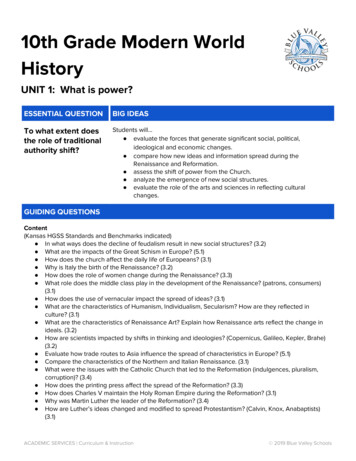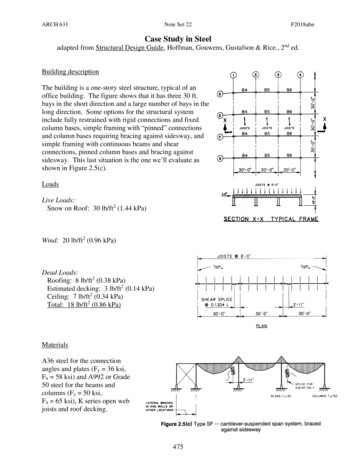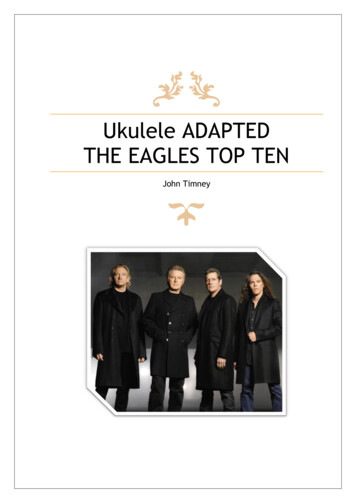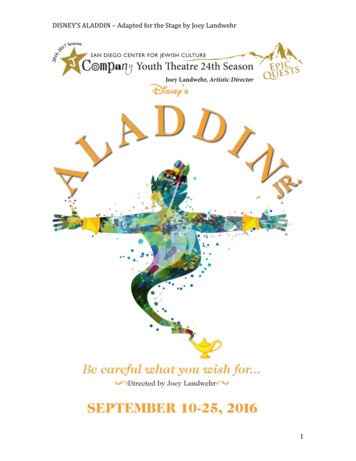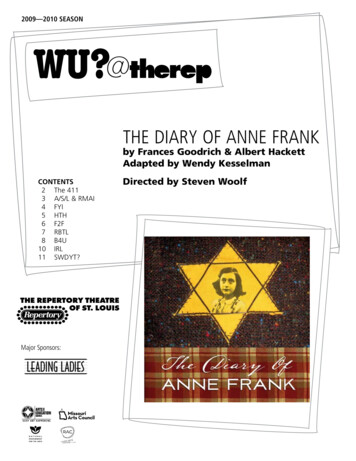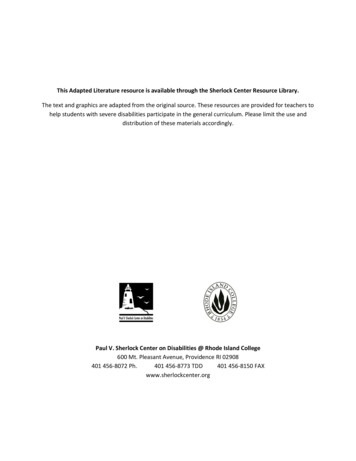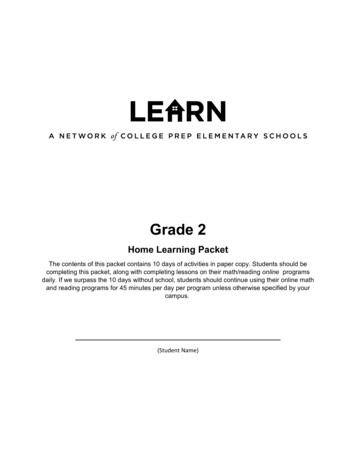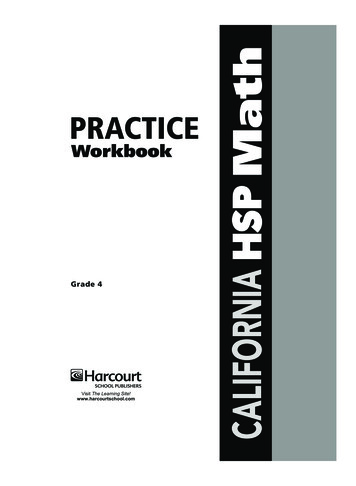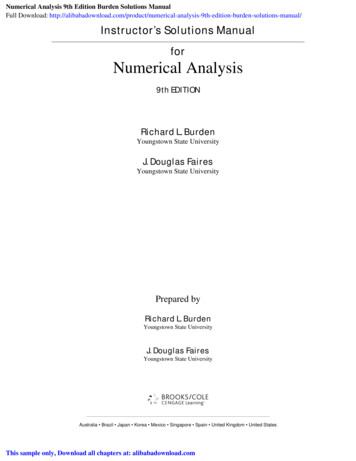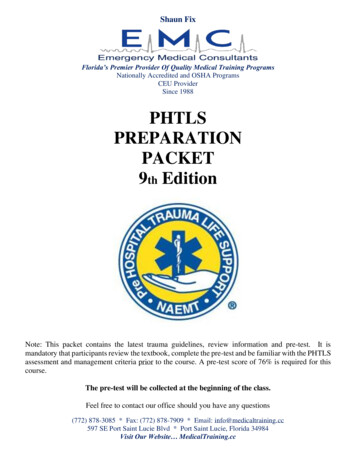
Transcription
World History - Adapted 9th GradeBased on: Ellis EG, Esler A. World History. Prentice Hall. 2003Edited by: John Faughnan (jfaughnan@gmail.com)URL: http://faughnan.com/scans/History.pdfLast updated: May 27, 2012ContentsSumer - 2000 BCE!5Judaism and Abraham - 2000 BCE!6Babylon and Hammurabi - 1790 BCE!6Iron Weapons: Hittites and Assyrians 1400 BCE to 600 BCE!8The Persians 600 BCE!9Egypt of the Nile 3100 BCE to 1100 BCE!10Ghana and the Sahara trade - Gold and Salt - 800 AD!11Islam, Mali and Mansa Musa: 1300 AD!12Songhai: Sonni Ali and Askia Muhammed 1450 AD!12Unit 2 Exam!13Unit 3 Exam!14African Summative Assessment - Songhai!15India 600 BC - 550 AD (about 1100 years)!16The Middle Kingdom: China 2000 BC - 220 AD: From Shang to Han!19Some dates to remember!19Geography and Ancient Chinaʼs Civilization (Map p. 1005)!19Han Science, Technology and Medicine 200 BC - 200 AD!191
Silk and the Silk Road!20The Shang, Zhou, Qin and Han Dynasties!21Philosophies of China: Mandate of Heaven, Daoism, Legalism, Confucianism!22Han Dynasty Project!23Boats: fishing and trade!23Soccer in the Han Dynasty!23Ancient Greece: 1400BC to 350BC!24Before the Golden Age: 1750 BC to 800 BC!24The Golden Age of Greece: 800 BC - 350 BC!25Sparta!25Athens 500 BC - 400 BC!25The Hellenistic Age: 350 BC - 150 BC!26Socrates, Plato and Aristotle (beliefs)!26Cultural Contributions to Western civilization (government, education, society)!26How does culture and community influence thinking (Athens, Sparta)!27Ancient Rome: 500 BC to 500 AD!28Key Ideas!28Geography!28Major Achievements of Ancient Rome!29The Growth of Roman Christianity!30Why did the people of ancient Italy (Rome) build a lasting empire?!30Why did the Roman Empire Decay and Fall?!31How was Rome like other civilizations of its time?!312
How did Rome change the world?!32The Pre-Invasion Americas 1400 BC to 1570 AD!33Human Settlement, Isolation, Invasion and Diseases!33Maya, Aztec and Inca: Geography!33Maya, Aztec and Inca - Compared!33The Middle Ages - Europe and the Middle East: 1040-1450!37Main Events!37Power in Europe in the Middle Ages!37The Magna Carta!37Islam and Christianity!37The five pillars of Islam!38The Crusades: Christian Turkey vs. the Islamic Turkish Empire 1100 - 1300!38The Causes of the Crusades!The European Renaissance 1450 - 1650!3940Medieval vs. Renaissance Ideas!40Rebellion against Rome: Causes of the Protestant Reformation!40Luthorʼs Ideas - Protestant Reformation!41Sea routes to Asia (China and India)!41What made the Renaissance possible!42Famous people of this time who changed the world!42Europe 1640-1815 - The Enlightenment. Revolutions in Science, Industry and Politics.!44Introduction!44Scientific Revolution: ideas and people!453
Absolutism (Absolute monarch)!46How did Absolutism and the Enlightenment make Revolutions?!46What was the Enlightenment? How is it related to the Renaissance, Protestant Reformation and the Scientific Revolution?!47Project: The Russian Revolution of 1917!Introduction!49494
Sumer - 2000 BCEA city-state is a place like our town but long ago.The cities of Sumer were between two rivers, the Tigris and the Euphrates. We call thisland Mesopotamia.In old days people lived along rivers. Water from the river helped grow things.The people of Sumer had laws and traditions and religion. Law, tradition and religion arethe “social classes”.Sumer had kings at the top. They had priests too. They were powerful.In the middle of the society were people who made things. They are called artisans. Thethings they made could be pretty. There were also people who sold things, called merchants.At the bottom of the society were the people who grew food. At the very bottom wereslaves, they had no choice.When the cities of Sumer started women could be rulers. Later they had less power.Their status fell over time.The Sumerians prayed to many gods. Their gods were like the Greek Gods, like Zeusand Apollo. Their gods ate and drank and got angry and had children.The Sumerians built homes for their gods. They built a pyramid (pointy) building. We callthem Ziggurats. At the top was a room for the god.Sumerians thought when they died they went under the ground, and lived in the dark.Sumerians invented writing. Maybe earlier cities people did that too, but we donʼt havetheir writing. Their writing looked like pictures. We call it cuneiform.The Sumerians also invented lots of math, even some algebra. They made calendars.They studied the night sky. They used wheeled carts to move things.The Sumerians invented the idea of the hour and the minute. They said 1 hour wouldhave 60 minutes.5
Judaism and Abraham - 2000 BCEAbraham lived in the city of Ur between the time of Sumer and the time of Babylon.He started a religion called Judaism. The Sumerians had many gods, but Abraham saidthere was only one god.These are some special things about Judaism compared to many religions of the time. Only one god (monotheism). Human kings were not gods, they had to obey god.God was everywhere, not limited to a location or region.Religious stories were written down. These written stories are called Torah.The Jewish god was only for Jewish people. They were chosen.Babylon and Hammurabi - 1790 BCEBabylon was a city state near Sumer.It was ruled by a king called Hammurabi. His armies took over (conquered) Sumer.Babylon became a nation.He made artisans carve the laws of his people onto a stone. We call this “The Code ofHammurabi”.6
The Code of Hammurabi told the people of the kingdom how to act.One section was about criminal law. It said how they should punish bad actions.Another section was about civil law. It said how families should behave and how to divide up property when a father died.7
Iron Weapons: Hittites and Assyrians 1400 BCE to 600BCEUntil this time weapons were made from metals of bronze and copper. These metals aresoft. The Hittites discovered how to use iron to make weapons. Iron is stronger thancopper and bronze.The Hittites lived east of the Tigris and Euphrates rivers (east of Mesopotomia) in anarea with a lot of iron. With their iron weapons they conquered Mesopotamia and otherlands.The Assyrians lived on the Tigris river. They learned how to make iron weapons fromthe Hittites. They loved to fight and kill.The Assyrians conquered many people. They took over from the Hittites.They learned from the people they conquered. They became less cruel.King Assurbanipol of the Assyrians created a great library at Nineveh.8
The Persians 600 BCEMesopotamia had many wars and empires over more than 1,000 years. Then came thePersians.The Persians brought many inventions in government. Most of all they invented usingcoins as money. Before this time people “bartered” (traded) things. They had a bartereconomy. After this time people traded coins for things. They had a money economy.Darius was a famous ruler of the Persians. During his time the Persians began usingcoins and having governors and collecting taxes and building roads. Darius madelaws for everyone. The Persians developed standard ways to weigh and measurethings.The Persians were Monotheists -- they had only one god. They invented ideas ofHeaven and Hell and judgment by a god.9
Egypt of the Nile 3100 BCE to 1100 BCEThe Nile is a river in Africa. It flows from Ethiopia north to the Mediterranean sea. Thenorth end runs through a great desert. That is what we call the land of Egypt.The Nile floods every year. When it floods it leaves mud (silt) behind. The silt is good forfarming.Egypt was created around 3100 BCE when King Menes conquered the people wholived on the Nile. He used the Nile to move along his very long and narrow kingdom inthe great desert.Egyptian Kings were men but they said they were gods. Egyptians prayed to them. Wecall those Kings Pharaohs.Pharaohs had ministers who ruled the land. We can them Viziers.Viziers ran departments like tax, farming and irrigation. They told Scribes what to do.Scribes told the Egyptian people what to do.Irrigation is taking water from a lake or river and using it to farm. Because the Egyptianslived along a river in the desert they needed irrigation to live. It was the most importantthing in EgyptThe Egyptian people developed technologies of building and water control. They builtpyramids for the dead bodies and treasures of their Pharaohs. They built large channelsto carry water from the Nile to farms. We call these irrigation channels. They built dikesto channel water and dams to create lakes and hold water. They stored water from therainy season to use in the dry season.10
Ghana and the Sahara trade - Gold and Salt - 800 ADGhana is a country in Africa. It is in the western part of Africa.In this map there are circles around Mesopotamia (Sumer, Tigris, Euphrates), Egypt andGhana. The Sahara Desert is between Egypt and Ghana. The Sahara has been gettingbigger over the past 4,000 years.One thousands years ago the people who lived between the Niger and Senegal riversformed a kingdom called Ghana.Remember that the people who lived between the Tigris and Euphrates created kingdoms like Sumer and people who lived on the Nile created Egypt. Rivers are importantfor ancient civilizations and modern too. We live on the Mississippi.The King of Ghana controlled trade in Salt and Gold.Humans need some salt to be healthy. In the ancient world Salt had to be mined fromthe earth; it was very important. Salt comes from sea water. There used to be sea water in the Sahara, when it dried out it left salt behind.Men dug gold from pits in the earth. Women washed out gold dust. Dust was put infeather quills to hide it. It was traded to North Africa (Morocco) and across the water toSpain (see map above). Camels were used to trade across part of the Sahara.11
Islam, Mali and Mansa Musa: 1300 ADThe religion of Islam started in the lands between Egypt and Mesopotamia around 700AD. It is based on the ideas of a man called Mohammed.Islam spread across Africa including Ghana and Mali.People who follow the religion of Islam are called Muslims.By 1300 AD Mali was very strong. It took over Ghana.Mansa means King in the language of Mali.Mansa Musa conquered neighbor states and put good laws in place. He attracted manywriters and students to Mali.Timbuktu is a city in Mali. It became a center of Islamic (Muslim) teaching.Songhai: Sonni Ali and Askia Muhammed 1450 ADSonghai took over from Mali. It was on the Niger river.Sonni Ali was a king of Songhai. He was not a Muslim. He made Songhai bigger andtook over the lands of Mali.Aski Mohamed took over from Sonni Ali. He was a Muslim. He formed a true government with departments like farming, army and treasury (money). He converted his people to Islam.12
Unit 2 Exam1. Sumer and many other ancient cities start near which things:a. Rivers that bring water and soil that are good for growing things.b. Mountains that bring shade.c. Deserts that are dry.2. Which of these social classes were a part of Sumer?a. Software developersb. Artisansc. Senatorsd. Scientists3. What technology was developed in Sumer?a. The telescopeb. The calendarc. The computerd. Paper4. What people first used iron weapons?a. The Sumeriansb. The Babyloniansc. The Hittites5. Which religion had only one God?a. Sumerianb. Babylonianc. Judaism13
Unit 3 ExamWest Africa 1000 AD and Mesopotamia 1000 BC: What do they have in common?1. What amount of time separates the Songhai Kindgom of west africa (1000 AD) andthe Hittite Kingdoms of mesopotamia (1000 BC)?a. 5,000 yearsb. 300 yearsc. 2,000 yearsd. 30 years2. Civilizations of Mesopotamia and civilizations of West Africa both started near:a. Mountainsb. Desertsc. Oceansd. Rivers3. What where Hittite and Songhai weapons made of?a. Bronzeb. Stonec. Woodd. Iron4. Where was Gold important for trade?a. Sumeriab. Songhaic. Babylon5. The Persians used money. Did the the West African civilizations use money too?a. Yesb. No6. Which civilizations had religious leaders?a. Persianb. Malic. Ghanad. Egyptione. All of the above7. Which civilizations had leaders elected by citizens?a. Persiab. Hittitec. Songhaid. Sumeriae. None of them14
African Summative Assessment - SonghaiIntroductionSonghai was a civilization located in . It started in the year . It ended in theyearBodyPeople settled in the area of Songhai because . This was the same reason people settled in Mesopotamia.The natural resources available to the people of Songhai included . Sumeria had someof the these, including .Songhai was run by a . The people had jobs like .The religion of Songhai was . The religion of ancient Israel was . Both religions weremonotheist/polytheist.In Egypt people built . In Songhai people built .In Sumer people wrote using . in the Sumerian language. In Songhai they wrote usingthe . language.ConclusionSonghai had some things in common with countries like Sumeria and Mesopotamia.They included .15
India 600 BC - 550 AD (about 1100 years)GeographyIn the northwest and northeast of India giant mountains capture snow and block invaders. The snow melts and makes rivers. The rivers bring water for growing food to thenorth.The Deccan Plateau (flat area) is high up, so the rivers donʼt get to it. It is dry. Few livethere.The coasts of India had water for food, fish, and trade.The Guptas: 320BC - 550 ADFor most of its history India was ruled by the Gupta kings. They started the Caste system. They were usually good rulers. Their religion was Hinduism. It was a religion ofmany, many local gods.The Caste System of the GuptasIndian religion and culture were very close. Together the divided all Hindu people intogroups called Castes. (During this time almost all Indians were Hindu.)Some Castes were based on jobs. Some were based on skin color, language, or history.Castes had strict divisions. People could only marry someone in the same caste. Children had the same castes as their parents (“hereditary”).High caste people had more money and special rules and good education and nicerjobs. The highest caste was and is called Brahmin.Low castes people were poor and had smelly or hard jobs and no education. The lowestcaste is Untouchable. They had a terrible life.Some people claim that the caste system made India stay the same for a long time, andit helped avoid wars inside India. There is no way to know if this is true or not.The Gupta rule ended 1,500 years ago, but Hindus in India still have Castes and theystill control many lives. The Caste system has been very persistent.Comparison: Castes in 500 AD India and Classes in America 2011In India of 500 AD there was one very dominant religion (Hinduism). Religion and culture divided people into Castes.16
In America of 2011 there are many religions, but Christianity is dominant. Christianitydoes not have the idea of a Caste or Class. In traditional Christian teaching the poor areoften said to be blessed, but rich people have to be extra good to earn Godʼs approval.Christian and Hindu religions have very different ideas about Class and Caste.Although the religious ideas are very different the cultures are more similar. Both Indiaof 500 AD and America of 2011 have something like Castes. In America we call themClasses. Class in America is mostly based on money. Poor people are Lower Class.Rich people are Upper Class. Everyone else is Middle Class.Someone born poor in America will usually stay poor (Lower Class). Someone born richwill usually stay rich (Upper Class). Most Americans marry within their class; poor marrypoor and rich marry rich. This is similar to Hindu Castes.Indians could never change their Caste. Americans can change, most often middleclass people can become poor. This is different.Modern American and ancient Indian rule is very different. Rulers in old India were always Brahmin. In American many presidents start out Lower Class. Both PresidentsClinton and Obama started life very poor.In ancient India Castes started out based on history and skin color and language. InAmerica Class membership is often related to skin color and history (ethnicity). Historically American slaves were similar to Hindu Untouchables.17
Ancient India: Study Guide Exam1. Which of these things were common to Buddhism and Hinduism?a. One Godb. Reincarnationc. Caste system2. Why did Hindus believe that a person was reincarnated as an untouchable?a. Bad luckb. Because they were good in a past life. (Good past life Karma)c. Because they were bad in a past life. (Bad past life Karma)3. What is the name of the river that was important for Indiaa. The Mississippi riverb. The Euphrates riverc. The Indus river4. Where does the water for the Indus River come from?a. The Himalayan mountainsb. The seac. The Rocky Mountains5. What is Karma?a. Actions that will affect your reincarnation.b. Good luckc. A disease18
The Middle Kingdom: China 2000 BC - 220 AD: FromShang to HanSome dates to remember 2000 BC: early Chinese writing1650 BC: Shang dynasty600 BC: Confucious200 BC: Shi Huangdi - the Cruel First Emperor200 BC: Han Dynasty starts0: Buddhism220 AD: End of Han DynastyGeography and Ancient Chinaʼs Civilization (Map p. 1005)Ancient China was very isolated. They were cut off from much of the world.To the North the land is cold and very dry. The Gobi desert is there. Very few people livethere even today.To the East is Ocean.To the Southeast is thick Jungle blocking the way to southeast asia.To the West and Southwest are mountains and desert and the high Tibetan Plateaublocking the way to India and the Middle East. The Tibetan Plateau is called the roof ofthe world.In India the the Indus River runs north to south downhill from the Deccan Plateau. InChina the Yangzi, Wei and Huan He rivers run west to east downhill from the TibetanPlateau. The rivers would flood in the spring when snow melted. The flooding left fertilesoil, but it also destroyed villages.Han Science, Technology and Medicine 200 BC - 200 ADHan scientists made better calendars and clocks by observing stars. They learned tomeasure earthquakes.Han physicians experimented with medicines from plants. They invented acupuncture,the idea that needles under the skin would cure disease. (This doesnʼt work, but at leastitʼs not harmful.)19
Han craftsman had advanced technologies before the Romans. They made paper fromwood pulp and invented the rudder for boats, fishing reels, stirrups on horses, wheelbarrows and suspension bridges.Silk and the Silk RoadSilk is a textile made from silkworm cocoons (a kind of moth larva, like a caterpillar). Silkwas developed in China around 3,500 BC. By the time of the Han dynasty China hadlearned to make beautiful silk cloth. Other countries would pay a lot for this silk, butsince China was cut off from the world it was hard to trade silk.Especially the West and Southwest of China are mountains and desert and the high Tibetan Plateau blocking the way to India and the Middle East.During the Han Dynasty many caravans learned how to cross these deserts and mountains. We call the paths they took the “silk road” because these traders took tons of silkto Europe, the Middle East and India. They traveled along rivers and around the sides ofgreat deserts and through great mountains. They brought back new foods, glass, fursand fabrics.20
The Shang, Zhou, Qin and Han DynastiesDynastyPeriodSignificanceShang1650-1027 BCEarly Chinese civilization, a lot like city-states ofSumer. Merchants and artisans in cities. Many gods.Worship of ancestor spirits.Zhou1027 - @220BC“Mandate of Heaven”. Emperor is near gods. Godspunish bad rulers with bad luck like Flood, Disease,War and Earthquake. Feudalism, many rulers whoserve King. First Books. Daoism. Early Confucius.Qin221 BC - 206BCVery short dynasty. Legalism - cruel and strict rules.All of China united with one First Emperor. Emperor isCruel. Great Wall. One kind of money. One kind ofwriting. Burned books.Han206 BC - 220ADEmperors are better. University. Roads. Economy better. Made China bigger. Silk Road. Confucianism verystrong. Civil Service with exams. First Golden Age ofChina.21
Philosophies of China: Mandate of Heaven, Daoism, Legalism, ConfucianismMandate inHanTeacher of thephilosophyUnknownLaoziHan FeiConfuciousBasic ideasGood rulershave goodluck. Bad ruleshave bad luck flood, disease,war, earthquake.Balance in allthings, but alsomany differentlocal religionsand beliefs.Worship of ancestorsObey ruler.Many rules,harsh punishment. Peasants are stupid.Harmonythrough rulesof five relationships: father/son, elder toyoungerbrother, husband to wife,ruler to subject,friend to friend.Obey authority.Men rule overwomen. Duties(obey parent)and Obligations (care forparent).Influence onGovernmentRulers tried tobe good.No influenceon government.Emperormakes laws.Cruel FirstEmperor.Han Dynastyfollowed Confucian rules.Han Civil Service based onConfucian stories.WritingsNoneThe Way ofVirtueThe Han Feizi(writings ofHan Fei)Analects ofConfucious22
Han Dynasty ProjectBoats: fishing and tradeInteresting Facts & Information: Ancient China a/ancient-china-ships/2414“The famous ancient ship known as a “junk” was also developed in China during theHan Dynasty from roughly the third century BCE until the third century CE. By the endof the Han Dynasty, junks were used on the ocean, and in subsequent dynasties sawthe development of the junk into a vessel for long ocean voyages.Soccer in the Han DynastySports and Games of Old 1/09/content 121606.htmsoccer, was first played in China in the Han Dynasty (206 BC –AD 220). Then, as now,the actual ball was made of leather, and inflated with hair and other soft fillings ratherthan air. . it was played by both men and women. This is attested by Han Dynasty historical records and images on bricks. The sportʼs emphasis at that time was on individual rather than team skills.Cuju, Ancestor of content 238798.htmThe game of cuju was first mentioned in the Zhan Guo Ce (under State of Qi's section)and later in the Sima Qian's Shiji (under Su Qin's biography), written during the HanDynasty. Some claim that the Yellow Emperor invented the game for military trainingpurposes, while others place its emergence during China's Warring States Period (476221 BC). In any case, it certainly existed during this period. A competitive form of cujuwas used as fitness training for military cavaliers, while other forms were played for entertainment in wealthy cities like Linzi.During the Han Dynasty (206 BC-AD 220), the popularity of cuju spread from the armyto the royal courts and upper classes. It is said that the Han emperor Wu Di enjoyed thesport. At the same time, cuju games were standardized and rules were established.Football matches were often held inside the imperial palace. A type of court called juchang was built especially for cuju matches, which had six crescent-shaped goal postsat each end.23
Ancient Greece: 1400BC to 350BCGreece today is a country on the north side of the Mediterranean sea. It is at the eastern end of Europe. The pink island in this picture is Crete, a land south of Greece. TheAegean sea is between Turkey and Greece and has many islands.Before the Golden Age: 1750 BC to 800 BCFrom 1750 BC to 800 BC several peoples lived and wrote stories in the region of Aegean sea. Homer was a poet who lived then. He is said to have written two famous poems, the Iliad and Odyssey.Because Greece is very mountainous, and because there are many islands, peoplelived in many small cities. The ancient Greeks were very good sailors and they settledfrom Spain to Egypt.24
The Golden Age of Greece: 800 BC - 350 BCGreece started with Kings and Queens (Monarchy). Then trade and technology (iron)made merchants and soldiers more powerful. Greece was ruled by oligarchs (rich people).Greece came to be dominated by two cities: Sparta and Athens.Both Sparta and Athens spoke Greek and they both worshipped the same gods - Zeus,Apollo, Ares, Athena and others. Both Sparta and Athens depended on the work ofslaves.SpartaSparta was run by warriors. It made money by conquering land and taking tribute andusing the labor of slaves.Sparta had two kings and an assembly of Spartan males over 30 (“citizens”). Spartanmen lived together in barracks from the age of 7 to 30.Spartan women had to obey their husbands and give up their sons. Because the menwere often at war they had more freedom than most women prior to the modern era.They could inherit property.Athens 500 BC - 400 BCAthens was first run by rich merchants and warriors (oligarchs) but over time it becamea limited democracy. Athens made money by trading and by using the labor of slaves.Free males with money could vote. Around 500 BC all male citizens over 30 were members of the Assembly. A special Council of 500 was chosen by lot (chance) and suggested laws to the Assembly.Women and girls in Athens had a difficult life. They mostly stayed home. They did not goto school.Athenian boys went to school. Learning and school were very important in Athens.Speaking in public was very important too.Athens had several great leaders like Solon, Pisistratus and Cleisthenes.After Athens and Sparta joined together to defeat Persia, Athens became very powerful.Pericles was a great leader around 450 BC. Pericles believed all male citizens shouldbe in the assembly, even poor people. During the time of Pericles Athens had manybuildings and universities.25
Around 400 BC Sparta and Persia conquered Athens. Athens was always influential, butit was never so powerful again.The Hellenistic Age: 350 BC - 150 BCGreece was conquered by Alexander of Macedonia around 340 BC. Alexander createda great empire, but after he died it mostly fought for 200 years. Greece still had a lot ofteachers and thinkers, but around 150 BC Rome grew in power.Socrates, Plato and Aristotle (beliefs)Socrates, Plato and Aristotle were great thinkers of Greece. Socrates taught Plato andPlato taught Aristotle. We call them philosophers.Socrates lived until around 400 BC. He asked questions that made people think hardaround the world. He made some people angry. When he was old they said he offendedthe gods. He was sentenced to die by drinking Hemlock (poison).Plato taught about government and wrote many books. He created a school called theAcademy. He liked logic, thinking carefully.Plato did not like democracy. He thought the smartest people should rule, people likehim. Although he thought men were mostly better than women, he thought some womenwere smart and could be Philosophers.Aristotle was a student of Plato. He thought people should live by the “golden mean”.They should balance everything. He set up the Lyceum to study all knowledge. He andhis students wrote books about politics, logic, biology, theater, art and many topics.Cultural Contributions to Western civilization (government, education, society)Greece was extremely influential to the civilization of Europe and from Europe to themodern Americas and related nations (“the west”).The first universities in the 1500s were based on the teachings of Aristotle. Ideas ofgovernment came from Greece, including ideas about oligarchy, democracy and the duties of Kings. Americaʼs founders were very influenced by Greek ideas of Democracy.The discipline and military culture of Sparta has influenced armies and military leadersover the past 2000 years.Greece created the Olympic games, which we still play.Greece created the idea of citizens as being important for the health of the city or nation.26
Greek sculpture was used as the example of best work in the western world. Greek architecture has always been imitated.Stories with lessons and morals, called Dramas, came from the Greeks and have beenpopular in the west.Greek mathematics and thinking about ethics and philosophy are still important today. Ittook over a thousand years to move much beyond Greek thinking in these areas.Greek scholars also invented History - telling stories about the past. Much of what weknow about the ancient world came from them.How does culture and community influence thinking (Athens, Sparta)The people living in Athens and Sparta spoke the same language and believed in thesame Gods (Zeus, Athena, etc). They had very different ideas. Their ideas came fromthe city where they were born. Their culture and community gave them ideas on how tolive, what was good, what people should do.Athens and Sparta were extremely different. That tells us culture is a very powerful influence.27
Ancient Rome: 500 BC to 500 ADKey Ideas Rome was and is a city in an region we call the Italian Peninsula. Long ago the people of the city of Rome controlled many lands. We call all of this ʻTheRoman Empireʼ. Rome is still around today! It is the capitol of modern Italy. Christianity started in Rome Todayʼs Europe was very influenced by Romeʼs Empire The Romans took over from the Greeks. Rome became powerful as Greece was getting weaker. We divide Roman history into 3 parts: Republic: 500 BC to about 0 AD. The best part of Roman history. Good government, healthy culture. Empire: 0 AD to 200 AD. Rome is very powerful, ruled by dictators (Emperors).Rome depends more and more on slavery, stops developing new ideas. Decline: 200 AD to 500 AD. Rome is powerful but troubled and falling apart.GeographyRomeʼs Empire included everything around the Mediterranean sea and then all of modern France and the southern part of modern England. Rome was the center of the Empire, it is in the brown box below. Today we call that land Italy.28
Major Achievements of Ancient RomeRome had a very great impact on the history of Europe and the Mediterranean.Rome learned a lot from the Greeks. When Rome conquered Greece it did not destroyGreek knowledge and culture. Ro
May 27, 2012 · for ancient civilizations and modern too. We live on the Mississippi. The King of Ghana controlled trade in Salt and Gold. Humans need some salt to be healthy. In the ancient world Salt had to be mined from the earth; it was very important. Salt comes from sea water. There used to be sea wa-

